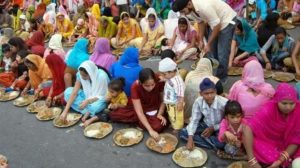
At a time when the entire nation is under severe lockdown, makeshift community kitchens are leading. In India, community kitchens have sprung up across cities to feed street dwellers, stranded migrants and food to the needy. The community kitchens set up by the government is with an objective to provide food to street dwellers and people from financially-backwards sections who are hit by the lockdown.
Women from rural areas of Jharkhand are playing a key role as the state to combat the threat of the novel virus. Around 2,500-odd women across all 24 districts are playing a pivotal role amid the lockdown. These women, part of various self-help groups run by Jharkhand State Livelihood Promotion Society (JSLPS), are working round-the-clock since the lockdown was imposed. Jharkhand State Livelihood Promotion Society (JSLPS) is an arm of the state rural development department. In far-flung areas of Santhal Pargana, Palamu, Chatra and Latehar district, the women are being deployed for doorstep delivery of food grains through public distribution system to the beneficiaries particularly the vulnerable sections of society. The women have started subsidised kitchens in Chaibasa, Deoghar,Ranchi and Jamtara to provide meals to the poor, daily wager and destitute.
The model of community kitchens (though an old concept) is a smart, practical program that has the ability to promote local food security. This model not only ensures that the participants have access to affordable food, but also in a sustainable and cost efficient manner. Community kitchens in the United States are often run by churches, similar to langars at gurudwaras, where members of the community volunteer their resources to feed others. But the current form seems to be involving the community to address larger social issues like food security which is the need of hour.
But the need of the hour is to open such free community kitchens in every panchayat. Schools and Anganwadis offer good alternatives. The government of Jharkhand apart from dal-bhat kendras has opened kitchens in several police stations. This model of community kitchen has met with success as most of the poor are getting cooked food once or twice a day .Report says , across the state, the kendras serve food once or twice a day. The state had 331 Dal Bhaat centres and added 537 more centres have been added. In addition, 411such centres are run by police stations. The money has been given to the district administrations, which looks after the operations.
‘Didi Kitchens’ are run by self-help groups in all panchayats and has been operating since 3rd April, 2020 in Jharkhand that feeds around 4.5 lakh-5 lakh people daily in this 21 Lockdown period. Across the state, 6,629 kitchens are run by the women self-help groups on voluntary basis under the Jharkhand State Livelihood Promotion Society (JSLPS). It has 2.5 lakh SHG groups in the state and their services are being used to fight the pandemic. Although, “Didi Kitchen is functioning across the state, but villages nearer to the panchayat are getting the benefits. The far away villages are often left out. An officer of this JSLPS reported that they have been allotted Rs 20,000- 40,000 per panchayat to buy essentials like oil, vegetables, rice, pulses among others
Kerala government’s hunger-free project is powered by an army of Kudumbashree, a self-help network of 43 lakh women. Community kitchens has also been set up in West Bengal, Uttar Pradesh, Madhya Pradesh, Bihar,Maharastra, Punjab,Rajasthan,Haryana and other states as well. A community kitchen and a food bank have been set up in Delhi too.
The scheme of community kitchen has a long history especially in the state of Tamil Nadu, where it was introduced by K. Kamraj government in 1960’s and expanded by M.G Ramachandran in 1982. Ever since it has been adopted by most of the states in India. In a bid to tackle the chronic hunger of India’s poor, in the recent years, more and more states across the country have been rolling out ‘soup kitchens’ for the poor. Usually running alongside a government initiative, soup kitchens are meal centres where food is offered to the hungry for free or at a reasonably low price. For example, the immense success of ‘Amma canteens’ in Chennai launched by the former Chief Minister late J Jayalalithaa has prompted many other state governments to do the same. In 2015, the Uttarakhand government launched 14 new state government-run eateries, like ‘Indira Amma Canteens’ that would serve a variety of local food at Rs 20 a plate. All the food served at these canteens is cooked by different women’s self-help groups. The state governments across the country have opened subsidised canteens and set up special community kitchens to provide food to the needy left without work. In Andhra Pradesh, NTR Anna canteens were launched in June 2016 and are already feeding hundreds of government employees relocated from Hyderabad to the state’s new capital Amravati. In Telangana, multiple TRP meal kiosks have been set in Hyderabad. Their frugal meal of rice, sambar and pickle (at Rs 5 per plate) feeds almost 15000 people daily.
In Odisha, Ahaar centres serving piping hot dalma (a watery mixture of lentil and boiled vegetables) with rice at just 5 rupees a plate have proven to be a big draw. While Chhattisgarh has enshrined its low-cost kitchens in law, Jharkhand’s ‘Mukhyamantri Dal Bhat Yojana’ is among the oldest of soup kitchens run in the country. Madhya Pradesh has also planned to launch its own version of subsidised canteens while Delhi has announced the launch of its ‘Aam Aadmi’ canteens.
Dr Sangita Laha (The author is an Associate Professor & Dean of Faculty in National University of Study & Research in Law).













